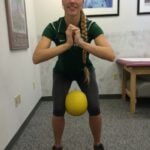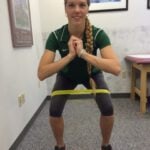 In a few short weeks, organized high school fall preseason practices will begin. This includes; football, soccer, cheerleading, women’s tennis, etc. Unfortunately, after a long break from participating in many of these activities, even young athletes are vulnerable to a variety of injuries, including a pulled muscle on the inside of the thigh called a groin strain. Groin strains are common in the pre and early season but with a few additions to an exercise and training program, prevention is possible.
In a few short weeks, organized high school fall preseason practices will begin. This includes; football, soccer, cheerleading, women’s tennis, etc. Unfortunately, after a long break from participating in many of these activities, even young athletes are vulnerable to a variety of injuries, including a pulled muscle on the inside of the thigh called a groin strain. Groin strains are common in the pre and early season but with a few additions to an exercise and training program, prevention is possible.
Groin Strain
A groin strain is a tear of the muscle fibers of the groin muscle. The groin muscle is group of muscles (adductor muscles) that run from the hip (inner pelvis) and attach to the thigh bone (femur). The adductor muscles work to stabilize the hip during weight bearing activities, such as running. They are very active when an athlete changes direction, especially side to side such as guarding an opponent with a defensive slide. This injury, like others, varies in intensity. Severe groin strain occurs when many muscle fibers are torn. In very severe cases, the boney attachment can be pulled so strongly that a small fracture can occur. Healing time can be as short as a few days or as long as weeks or even months.
The Most Common Causes of a Groin Strain
- Overuse – every time the foot hits the ground the hip adductor muscles must contract to keep the hip and leg from wobbling side to side or turning in and out. If there is not adequate time allowed for rest between workouts or competition, then the muscles may be fatigued and become vulnerable to injury. Also, overuse of the same muscles without rest may make them irritated and inflamed.
- Inadequate Warm-up – a warm muscle stretches like a piece of gum warmed up in your mouth. When you pull the warm gum, it stretches. However, if you drink an ice cold drink with gum in your mouth and then stretch the gum, it will tear instead of stretch. A good warm-up will prevent tearing and prepare the nervous system for sudden movements and changes in direction.
- Sudden Movement – quick sprint, sudden change in direction, quick turn with an unexpected force or slip.
- Poor Body Mechanics – especially when moving or lifting a heavy load away from your center of gravity.
- Forceful Contact or Loss of Traction – when a leg is forced away from the body by an outside force (tackle in football) or slip on grass or ice.
Symptoms of a Groin Strain
- Pain - usually occurs gradually. However, a sudden onset can occur, especially associated with a sudden twist or fall. Movement of the hip or change in direction reproduces pain in the groin. Touching the groin area and inside thigh reproduces pain.
- Swelling/Discoloration – swelling and black and blue coloration can occur in the inner thigh after increase activity at the end of the day.
- Stiffness – in the hip and thigh is more noticeable in the morning and improves with movement. However, overuse can create more pain and swelling and lead to stiffness also.
- Weakness –
- Loss of Function-
Your family physician will examine your hip and groin to determine if you have groin strain. In more advanced cases you may be referred to an orthopedic surgeon for further examination and treatment. An X-ray, MRI or bone scan will show the extent of the tear and if the bone is involved. The diagnosis will determine if you problem if minor, moderate or severe.
Treating a Groin Strain
There are many conservative options. You and your family physician or orthopedic surgeon will decide which choices are best.
- Anti-inflammatory Medications: such as aspirin, acetaminophen or ibuprofen to reduce pain and swelling.
- Orthopedic Physical Therapy: such as heat, cold, ultrasound, electrical stimulation, joint mobilization, massage, range of motion exercises, strengthening exercises, and supportive compression strapping.
- Activity Modifications: if it is not the week of the big game, rest, avoid running or stretching/stressing of the thigh muscles.
- Supportive Devices: such as thigh wraps or sleeves, compression shorts (like those worn under basketball shorts) can provide compression and relief.
Preventing a Groin Strain
- Warm -Up: a pre-activity slow jog or exercise bike and/or massage to the area to warm up the muscles prior to play.
- Stretching: Indian sit stretch, Hurdler stretch, Lying hamstring wall stretch
- Strengthening Exercises: weight training for legs, including inside and outside leg muscles, slide drill and cross kick against resistance tubing
- Hip Squeeze Walk – place ball between legs and walk sideways without allowing the ball to drop - 3 X 10 (See Photo A)
- Hip Spread Walk – place band around knees and walk sideways while pushing into the band – 3 X 10 (See Photo B)
- Agility Drills: figure 8, cross-over, tire or disc running
- Compression Shorts: like those worn under basketball shorts or baseball pants
- Cool Down: use ice to the effected area after exercise or sport
-

-
Photo A: Hip squeeze walk
-

-
Photo B: Hip spread walk
SOURCES: Journal of Physical Medicine & Rehabilitation and American Academy of Orthopaedic Surgeons
MODEL: Katherine Weaver
Visit your doctor regularly and listen to your body.
NEXT MONDAY – Read Dr. Paul J. Mackarey “Health & Exercise Forum” in the Scranton Times-Tribune.
This article is not intended as a substitute for medical treatment. If you have questions related to your medical condition, please contact your family physician. For further inquires related to this topic email: drpmackarey@msn.com
Paul J. Mackarey PT, DHSc, OCS is a Doctor in Health Sciences specializing in orthopaedic and sports physical therapy. Dr. Mackarey is in private practice and is an associate professor of clinical medicine at The Commonwealth Medial College.
 In a few short weeks, organized high school fall preseason practices will begin. This includes; football, soccer, cheerleading, women’s tennis, etc. Unfortunately, after a long break from participating in many of these activities, even young athletes are vulnerable to a variety of injuries, including a pulled muscle on the inside of the thigh called a groin strain. Groin strains are common in the pre and early season but with a few additions to an exercise and training program, prevention is possible.
In a few short weeks, organized high school fall preseason practices will begin. This includes; football, soccer, cheerleading, women’s tennis, etc. Unfortunately, after a long break from participating in many of these activities, even young athletes are vulnerable to a variety of injuries, including a pulled muscle on the inside of the thigh called a groin strain. Groin strains are common in the pre and early season but with a few additions to an exercise and training program, prevention is possible.